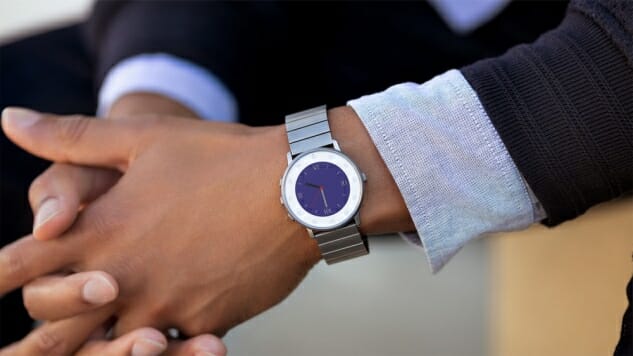
After kickstarting the smartwatch market in 2012, Pebble seemed poise to become a major player once wearable technology actually took off with the masses. Fast forward to 2017, and Pebble no longer exists. So, what does that mean for wearables as a whole?
Pebble raised tens of millions of dollars on Kickstarter for its various product lines, from the original Pebble all the way up to the Pebble Time Round and Pebble 2. And, unlike a lot of well-meaning crowdfunding tech projects, the final products were rock solid. Tech media the world over repeatedly heralded Pebble as the best smartwatch platform on the market, which helped the company land deals to get its products premium shelf space everywhere from Best Buy to Target. But, not even good products could save Pebble from becoming nothing more than a footnote for tech nerds, and a bundle of intellectual property now being retrofitted into Fitbit’s next line of devices.
The wearables market became a bubble the moment it was rumored Apple would enter the space with the Apple Watch, and everyone assumed consumers would start buying once the big players cranked out a few products. These are the same companies — Apple, Samsung, LG — that make phones and can bank on them selling, because every two years, or less, people need new phones. The assumption was it would be the same with wearable technology, but there’s a problem: smartwatches are still looking for the “killer app” that makes them essential to daily life, the way smartphones already are. Despite the best efforts, no one has found it yet.
Sales figures are tricky to track, but we’ll look at the Apple Watch as a proof of concept. An IDC report says shipments crashed by 50 percent at the end of last year, while data from Canalys says device shipments have technically increased by around 60 percent. Yes, those numbers don’t add up. Regardless, there’s little doubt Apple has sold millions of Apple Watches (the company doesn’t release specific sales data), but it’s still a drop in the bucket compared to the billion iPhones the company has sold to date.
Smartwatches started with a focus on notifications, but that hasn’t proven essential enough to push wearables beyond a niche market. It’s handy, sure, but not everyone needs every email and text message on their wrist. Then, the attention turned to fitness, but companies like Fitbit and Misfit have yet to truly break through to mainstream success, with the former struggling mightily of late. Instead, the market remains fragmented, with most smartwatch companies scrambling to turn their flagship devices into jacks of all trades. The results have been less than stellar.
 The current generation of smartwatches are almost exclusively big, bulky, platform-trapped, with a frequently-off screen that’s barely capable of surviving a full day between charges. For a device that’s supposed to blend seamlessly into your daily life, those aren’t the makings of breakout success. But, ironically enough, the now-defunct Pebble checked pretty much every box that should’ve had it flying off shelves. The battery lasted close to a week, it wasn’t huge and bulky (and the Round was downright gorgeous), it was platform agnostic and the color e-paper screen was always on. Plus, the three-button OS was dead-simple and just worked. No learning curve required. Hell, it was even waterproof from the start. If people actually wanted a smartwatch, Pebble was making damn fine ones.
The current generation of smartwatches are almost exclusively big, bulky, platform-trapped, with a frequently-off screen that’s barely capable of surviving a full day between charges. For a device that’s supposed to blend seamlessly into your daily life, those aren’t the makings of breakout success. But, ironically enough, the now-defunct Pebble checked pretty much every box that should’ve had it flying off shelves. The battery lasted close to a week, it wasn’t huge and bulky (and the Round was downright gorgeous), it was platform agnostic and the color e-paper screen was always on. Plus, the three-button OS was dead-simple and just worked. No learning curve required. Hell, it was even waterproof from the start. If people actually wanted a smartwatch, Pebble was making damn fine ones.
But, therein lies the real problem: most people don’t really want a smartwatch. Even a pretty good one that bordered on great. Pebble created wearable tech that filled a niche no one else was filling and it still couldn’t sell enough product to survive in the market it started. Wearable technology is here, but the world at large isn’t ready for it. Not yet.
With Pebble out of the way, it’s now a two-horse race. Google is rolling out Android Wear 2.0, and Apple has fully rebuilt its watchOS from the ground up with Apple Watch Series 2. It shows the companies with resources to survive will continue iterating and evolving — and that’s good, because there’s still a lot of work to do. Wearable technology could still be an integral part of our daily lives someday. It obviously won’t be the Pebble or the (equally abandoned) Google Glass, but a company will find that perfect use that will make wearable technology a necessity. The batteries will have to get stronger, screens better and the operating systems less complicated. A company like Apple can afford to sell a few million watches a year and wait for the market to evolve. Smaller players, obviously, cannot.
It might be fitness; it might be mobile purchases; it might be GPS; it might be notifications; it might be something completely different that no one has thought of yet — or a combination of all of the above — but we’re all still waiting on that “killer app.” And we’ll keep waiting.